Classic French Toast: the mere mention of it conjures up images of cozy weekend mornings, the comforting aroma of cinnamon and vanilla wafting through the air. But this isn’t just breakfast; it’s a culinary hug, a sweet start to the day that transcends generations. Have you ever wondered how such a simple dish could hold so much power?
While often associated with France, the origins of French toast, or something very much like it, can be traced back to ancient Rome. Called “Pan Dulcis,” stale bread was soaked in milk and eggs and then fried a resourceful way to avoid wasting food. The French version, “pain perdu” (meaning “lost bread”), carries the same thrifty spirit. It’s a testament to the ingenuity of cooks throughout history who transformed humble ingredients into something truly special.
What is it about Classic French Toast that makes it so universally loved? Perhaps it’s the delightful contrast between the crispy, golden-brown exterior and the soft, custardy interior. Or maybe it’s the endless possibilities for customization from a simple dusting of powdered sugar to a decadent topping of fresh berries and whipped cream. Whatever the reason, this dish is a guaranteed crowd-pleaser, perfect for a leisurely brunch or a quick and satisfying weekday breakfast. Join me as we explore the secrets to making the perfect batch of this timeless classic!
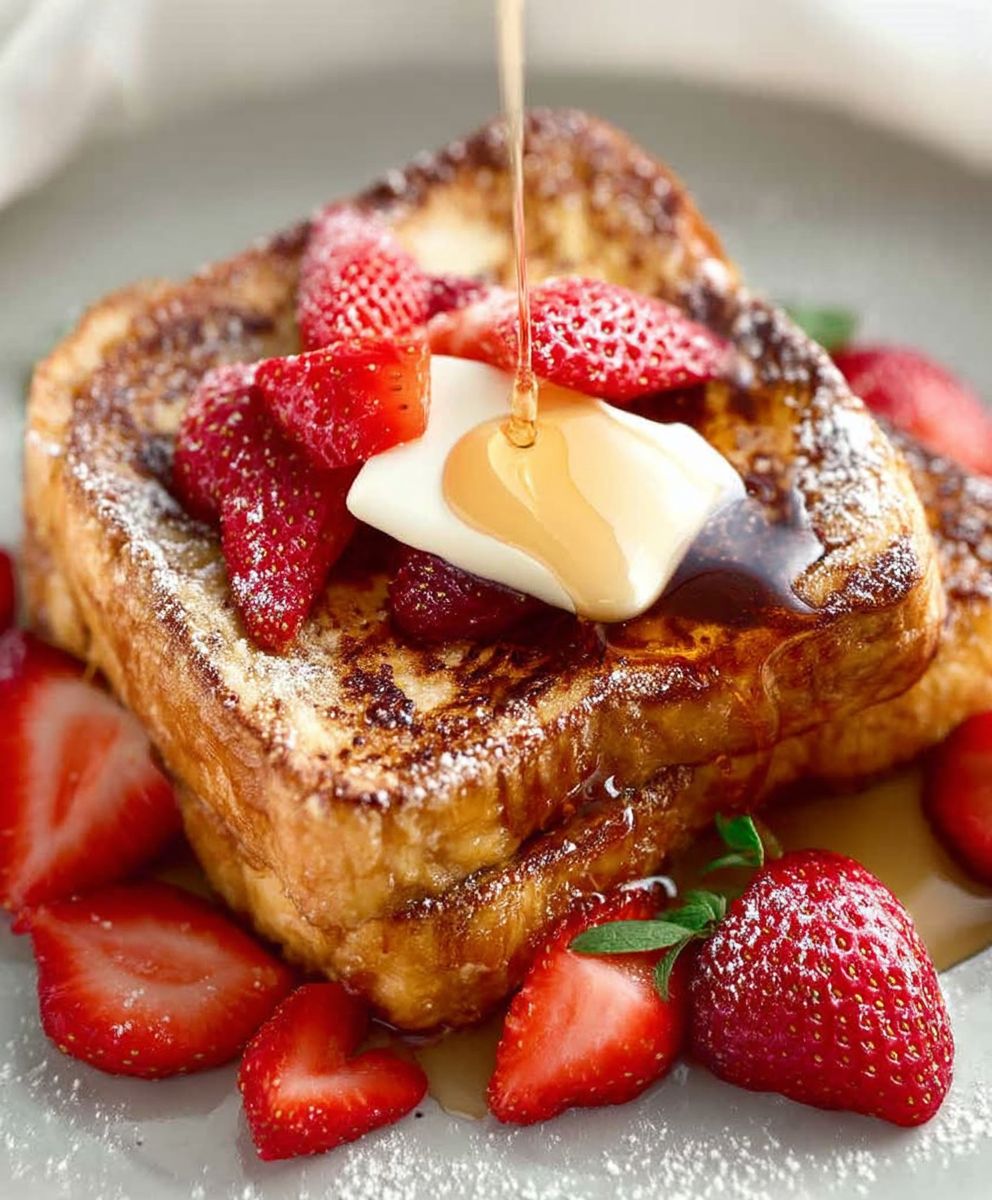
Ingredients:
- 6 large eggs
- 1 cup whole milk
- 1/2 cup heavy cream
- 1/4 cup granulated sugar
- 1 tablespoon vanilla extract
- 1/2 teaspoon ground cinnamon
- 1/4 teaspoon ground nutmeg
- Pinch of salt
- 1 loaf (about 1 pound) challah, brioche, or Texas toast, cut into 1-inch thick slices
- 4 tablespoons unsalted butter, for cooking
- Maple syrup, for serving
- Powdered sugar, for serving (optional)
- Fresh berries, for serving (optional)
Preparing the Custard:
Okay, let’s get started! The key to amazing French toast is a rich and flavorful custard. This is where all the magic happens, so pay close attention!
- Whisk the Eggs: In a large, shallow dish (like a baking dish or a wide bowl), crack all 6 eggs. Whisk them vigorously until they are light and frothy. This ensures that the custard will be smooth and evenly distributed. Don’t be afraid to really get some air in there!
- Add the Dairy: Pour in the whole milk and heavy cream. The combination of milk and cream is what gives the French toast its signature richness. If you want a slightly lighter version, you can use all milk, but trust me, the cream makes a difference!
- Sweeten and Spice: Add the granulated sugar, vanilla extract, cinnamon, nutmeg, and a pinch of salt. The sugar adds sweetness, the vanilla adds a lovely aroma, and the cinnamon and nutmeg provide warmth and depth of flavor. The pinch of salt enhances all the other flavors, so don’t skip it!
- Combine Thoroughly: Whisk all the ingredients together until they are completely combined and the sugar is dissolved. You want a smooth, homogenous mixture. There shouldn’t be any streaks of egg yolk or undissolved sugar.
- Strain (Optional but Recommended): For an extra smooth custard, you can strain the mixture through a fine-mesh sieve. This will remove any bits of egg white that didn’t fully incorporate. This step is optional, but it will result in a more refined texture.
Soaking the Bread:
Now comes the crucial step: soaking the bread. The type of bread you use is important, and the soaking time is even more so. We want the bread to be saturated with the custard, but not so soggy that it falls apart.
- Prepare the Bread: Make sure your bread is sliced into 1-inch thick slices. This thickness is ideal for soaking up the custard without becoming too flimsy. If your bread is too thin, it will likely fall apart during cooking.
- Submerge the Bread: Place a few slices of bread into the custard mixture at a time. Let them soak for about 2-3 minutes per side. The exact soaking time will depend on the type of bread you’re using. Challah and brioche are more absorbent than Texas toast, so they may require slightly less soaking time.
- Check for Saturation: Gently press down on the bread with a fork or spatula to ensure that it is fully submerged in the custard. You want the bread to be saturated all the way through, but not dripping wet.
- Remove Excess Custard: Carefully lift the soaked bread from the custard and let any excess drip back into the dish. You don’t want the bread to be overly saturated, as this can lead to soggy French toast.
- Repeat: Repeat the soaking process with the remaining slices of bread, adding more custard to the dish as needed.
Cooking the French Toast:
Alright, we’re almost there! Now it’s time to cook the French toast to golden-brown perfection. The key here is to use medium heat and to be patient. We want the inside to be cooked through and the outside to be nicely browned.
- Heat the Pan: Heat a large skillet or griddle over medium heat. Add about 1 tablespoon of butter to the pan and let it melt completely. The butter should coat the bottom of the pan evenly.
- Cook the First Side: Place the soaked bread slices into the hot pan, being careful not to overcrowd it. Cook for about 2-3 minutes per side, or until the bottom is golden brown and crispy.
- Flip and Cook the Second Side: Carefully flip the French toast slices with a spatula and cook for another 2-3 minutes, or until the second side is golden brown and the inside is cooked through.
- Check for Doneness: To check if the French toast is cooked through, you can gently press down on the center with a fork. If it feels firm and springy, it’s ready. If it feels soft and mushy, it needs to cook a little longer.
- Keep Warm (Optional): If you’re making a large batch of French toast, you can keep the cooked slices warm in a preheated oven (200°F) while you cook the remaining slices. This will prevent them from getting cold and soggy.
- Repeat: Repeat the cooking process with the remaining soaked bread slices, adding more butter to the pan as needed.
Serving and Enjoying:
Finally, the best part! It’s time to serve and enjoy your delicious homemade French toast. There are so many ways to customize it to your liking, so get creative!
- Serve Immediately: Serve the French toast immediately while it’s still warm and crispy.
- Top with Maple Syrup: Drizzle generously with maple syrup. This is a classic pairing that never gets old.
- Add Powdered Sugar: Dust with powdered sugar for a touch of sweetness and elegance.
- Garnish with Fresh Berries: Top with fresh berries, such as strawberries, blueberries, or raspberries, for a burst of flavor and color.
- Other Toppings: Get creative with other toppings, such as whipped cream, chocolate sauce, Nutella, or chopped nuts. The possibilities are endless!
- Enjoy! Take a bite and savor the deliciousness of your homemade French toast. You deserve it!
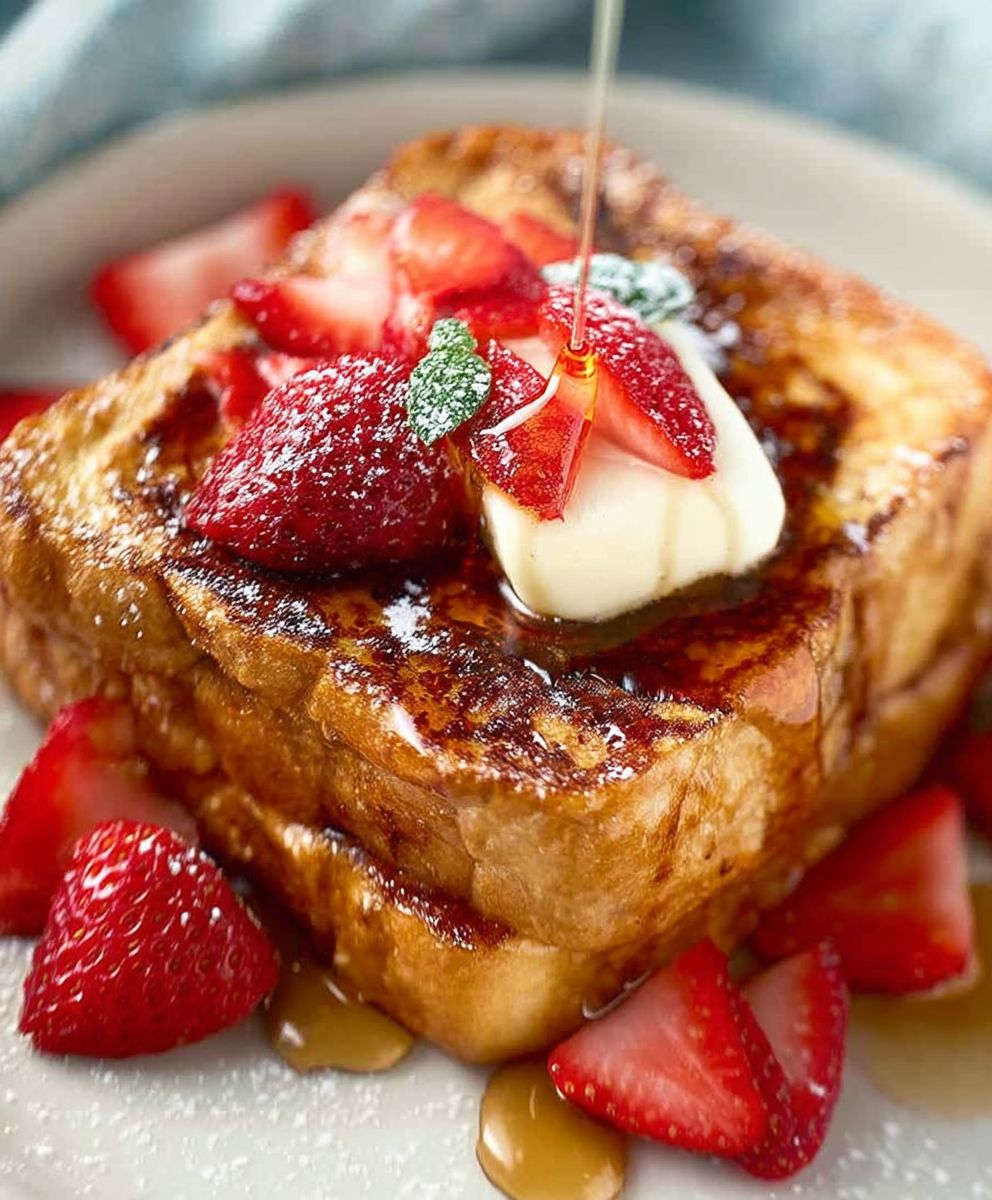
Conclusion:
This isn’t just any breakfast; it’s an experience. This Classic French Toast recipe is a must-try because it elevates a simple dish to something truly special. The combination of the rich custard, the perfectly browned exterior, and the soft, pillowy interior is simply irresistible. It’s the kind of breakfast that makes you want to linger at the table, savoring every bite. Forget those dry, bland French toast attempts of the past; this recipe guarantees golden, delicious results every single time.
But the best part? It’s incredibly versatile! While I’ve shared my go-to method, feel free to get creative. For a truly decadent treat, try using brioche or challah bread. Their slightly sweet flavor and airy texture will take your French toast to the next level. Or, if you’re looking for a healthier option, whole wheat bread works beautifully too. Just be sure to soak it a little longer to ensure it’s fully saturated with the custard.
Serving Suggestions:
The possibilities are endless when it comes to toppings! A simple dusting of powdered sugar and a drizzle of maple syrup is always a classic choice. But don’t be afraid to experiment. Fresh berries, such as strawberries, blueberries, or raspberries, add a burst of freshness and color. A dollop of whipped cream is always a welcome addition, and a sprinkle of chopped nuts provides a satisfying crunch.
For a more savory twist, try topping your French toast with a fried egg and a sprinkle of chives. Or, for a truly indulgent experience, add a scoop of vanilla ice cream and a drizzle of chocolate sauce. You could even create a French toast sandwich with ham and cheese for a delicious brunch option.
Variations to Explore:
* Cinnamon Roll French Toast: Swirl cinnamon roll dough into the custard before dipping the bread.
* Nutella Stuffed French Toast: Spread Nutella between two slices of bread before dipping.
* Savory French Toast: Omit the sugar from the custard and add herbs like thyme or rosemary. Top with cheese and vegetables.
* Baked French Toast Casserole: Assemble the French toast in a baking dish and bake it in the oven for an easy brunch option.
I truly believe that this Classic French Toast recipe will become a staple in your breakfast rotation. It’s perfect for a lazy weekend morning, a special occasion, or even a quick and easy weeknight dinner. It’s a crowd-pleaser that’s sure to impress everyone who tries it.
So, what are you waiting for? Gather your ingredients, follow the simple steps, and prepare to be amazed. I’m confident that you’ll love this recipe as much as I do. And most importantly, don’t be afraid to put your own spin on it! Experiment with different breads, toppings, and variations to create your own signature French toast masterpiece.
I can’t wait to hear about your experience! Please, try this recipe and share your photos and comments below. Let me know what variations you tried and what toppings you loved the most. I’m always looking for new and exciting ways to enjoy this classic dish. Happy cooking, and bon appétit! I’m sure you will find this Classic French Toast recipe to be a winner!
Classic French Toast: The Ultimate Recipe for a Perfect Breakfast
Classic French toast with challah, brioche, or Texas toast soaked in rich custard. Golden and delicious!
Ingredients
- 6 large eggs
- 1 cup whole milk
- 1/2 cup heavy cream
- 1/4 cup granulated sugar
- 1 tablespoon vanilla extract
- 1/2 teaspoon ground cinnamon
- 1/4 teaspoon ground nutmeg
- Pinch of salt
- 1 loaf (about 1 pound) challah, brioche, or Texas toast, cut into 1-inch thick slices
- 4 tablespoons unsalted butter, for cooking
- Maple syrup, for serving
- Powdered sugar, for serving (optional)
- Fresh berries, for serving (optional)
Instructions
- In a large, shallow dish, whisk the eggs vigorously until light and frothy.
- Pour in the whole milk and heavy cream.
- Add the granulated sugar, vanilla extract, cinnamon, nutmeg, and a pinch of salt.
- Whisk all ingredients together until completely combined and the sugar is dissolved.
- (Optional) Strain the mixture through a fine-mesh sieve for an extra smooth custard.
- Make sure your bread is sliced into 1-inch thick slices.
- Place a few slices of bread into the custard mixture at a time. Let them soak for about 2-3 minutes per side.
- Gently press down on the bread with a fork or spatula to ensure that it is fully submerged in the custard.
- Carefully lift the soaked bread from the custard and let any excess drip back into the dish.
- Repeat the soaking process with the remaining slices of bread, adding more custard to the dish as needed.
- Heat a large skillet or griddle over medium heat. Add about 1 tablespoon of butter to the pan and let it melt completely.
- Place the soaked bread slices into the hot pan, being careful not to overcrowd it. Cook for about 2-3 minutes per side, or until the bottom is golden brown and crispy.
- Carefully flip the French toast slices with a spatula and cook for another 2-3 minutes, or until the second side is golden brown and the inside is cooked through.
- To check if the French toast is cooked through, you can gently press down on the center with a fork. If it feels firm and springy, it’s ready. If it feels soft and mushy, it needs to cook a little longer.
- (Optional) If you’re making a large batch of French toast, you can keep the cooked slices warm in a preheated oven (200°F) while you cook the remaining slices.
- Repeat the cooking process with the remaining soaked bread slices, adding more butter to the pan as needed.
- Serve the French toast immediately while it’s still warm and crispy.
- Drizzle generously with maple syrup.
- Dust with powdered sugar for a touch of sweetness and elegance.
- Top with fresh berries, such as strawberries, blueberries, or raspberries, for a burst of flavor and color.
- Get creative with other toppings, such as whipped cream, chocolate sauce, Nutella, or chopped nuts.
- Enjoy!
Notes
- The type of bread you use is important. Challah and brioche are more absorbent than Texas toast, so they may require slightly less soaking time.
- For an extra smooth custard, you can strain the mixture through a fine-mesh sieve.
- Be patient when cooking the French toast. We want the inside to be cooked through and the outside to be nicely browned.

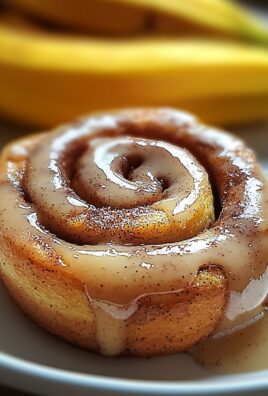
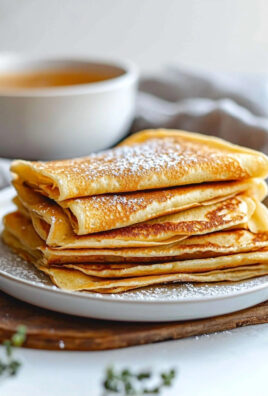
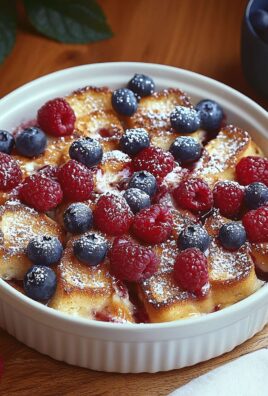
Leave a Comment